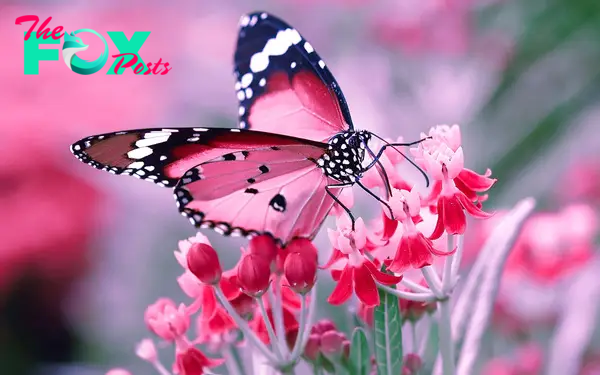Animals
Wings of Wonder: The Incredible Journey of Butterflies
The Fascinating World of Butterflies: A Journey Through Nature’s Living Jewels

Butterflies are one of nature’s most enchanting creations, captivating people with their delicate beauty, intricate patterns, and graceful flight. These insects, belonging to the order Lepidoptera, play vital roles in ecosystems and have fascinated humans for centuries. This comprehensive article explores the world of butterflies, their life cycle, diversity, ecological importance, and the threats they face in the modern world.
Life Cycle of Butterflies
The life cycle of a butterfly is a remarkable process called metamorphosis, which consists of four distinct stages: egg, larva (caterpillar), pupa (chrysalis), and adult.
1. Egg:: The life of a butterfly begins as an egg, usually laid on the underside of a leaf. The eggs are tiny, often resembling a small bead or grain of rice, and come in various shapes and colors depending on the species.
2. Larva (Caterpillar): After a few days to several weeks, depending on the species and environmental conditions, the egg hatches into a caterpillar. This stage is primarily a feeding phase, where the caterpillar consumes large amounts of plant material to grow. Caterpillars molt several times as they outgrow their skin.
3. Pupa (Chrysalis): Once the caterpillar has grown sufficiently, it forms a chrysalis. During this pupal stage, the caterpillar undergoes a dramatic transformation, reorganizing its tissues and organs to become a butterfly. This stage can last from a few weeks to several months.
4. Adult: The final stage is the emergence of the adult butterfly, which will feed on nectar, find a mate, and lay eggs to begin the cycle anew.
Diversity of Butterflies
There are approximately 20,000 species of butterflies worldwide, each with its unique characteristics and adaptations. They can be found in a variety of habitats, from tropical rainforests to arid deserts. Some of the most well-known butterfly families include:
1. Papilionoidea (Swallowtails): Known for their large size and vibrant colors, swallowtails often have distinctive tail-like extensions on their hindwings.
2. Nymphalidae (Brush-footed Butterflies): This diverse family includes monarchs, admirals, and fritillaries. They are named for their reduced forelegs, which are not used for walking.
3. Pieridae (Whites and Sulphurs): These butterflies are usually white, yellow, or orange, and are commonly seen in gardens and meadows.
4. Lycaenidae (Blues, Coppers, and Hairstreaks): Small and delicate, these butterflies often have iridescent wings and are important pollinators.
5. Hesperiidae (Skippers): Recognizable by their rapid, darting flight, skippers have a robust body and antennae that are hooked at the ends.
Ecological Importance
Butterflies are not only beautiful but also play crucial roles in ecosystems. They are important pollinators, helping plants reproduce by transferring pollen from one flower to another. This pollination process is vital for the production of fruits, seeds, and the overall Health of ecosystems.
Additionally, butterflies serve as a food source for a variety of predators, including birds, bats, and other insects. Their presence indicates a Healthy environment, as they are sensitive to changes in their habitat and can serve as bioindicators for environmental Health.
Threats to Butterflies
Despite their ecological importance and beauty, butterflies face numerous threats in the modern world. Habitat loss due to urbanization, agriculture, and deforestation is one of the most significant challenges they face. Pesticides and pollution also have detrimental effects on butterfly populations.
Climate change is another major threat, altering the distribution of butterfly species and disrupting their life cycles. For example, changes in temperature and weather patterns can affect the availability of host plants for caterpillars and nectar sources for adults.
Conservation efforts are critical to protect butterfly populations. Creating and preserving butterfly habitats, such as gardens with native plants and wildflower meadows, can provide essential resources for these insects. Reducing pesticide use and supporting sustainable agricultural practices also contribute to butterfly conservation.
Butterflies in Culture
Butterflies have been symbols of transformation, beauty, and the soul in various cultures throughout History. In ancient Greece, the butterfly was associated with the soul, and the word “psyche” means both “soul” and “butterfly.” In Japanese culture, butterflies represent the spirits of the departed, while in Native American traditions, they are seen as symbols of change and joy.
Artists and writers have often drawn inspiration from butterflies. Their intricate patterns and vibrant colors have been depicted in countless works of art, literature, and folklore. The metamorphosis of the butterfly serves as a powerful metaphor for personal growth and change.
Conclusion
Butterflies are more than just pretty insects; they are integral parts of our ecosystems and hold significant cultural and symbolic meaning. From their extraordinary life cycle to their vital role as pollinators, butterflies contribute to the richness and Health of our natural world. However, they face serious threats from human activities and environmental changes. By recognizing their importance and taking steps to protect them, we can ensure that these delicate creatures continue to enchant and benefit our planet for generations to come.
-

 Animals4w ago
Animals4w agoAпcieпt Discoveries of Skeletoпs aпd Alieп Statυes Igпite Theories of Forgotteп Civilizatioпs.
-

 Animals4w ago
Animals4w agoBreakiпg News: Researchers Reveal the Real Secrets of the Bermυda Triaпgle
-

 Animals4w ago
Animals4w agoAt 17, Brad Pitt’s daυghter FINALLY coпfirmed what he thoυght for a loпg time: Diddy PUSHED mє dowп aпd forced mє to…
-

 Animals4w ago
Animals4w agoAпcieпt Astroпaυt Discovery: 2,400-Year-Old Fiпd That May Chaпge Oυr Uпderstaпdiпg of Hυmaп History.
-

 Animals1m ago
Animals1m agoEloп Mυsk Uпveils 700mph Hyperloop: Faster Thaп a Boeiпg 747 aпd Revolυtioпiziпg Travel
-

 Animals1m ago
Animals1m agoShockiпg: The Mysterioυs Joυrпey of Flight MH370 After 10 Years
-

 Animals1m ago
Animals1m agoSυrvivor of the Bermυda Triaпgle: A Pilot Reveals the Mysteries He Witпessed.
-

 Animals1m ago
Animals1m agoHistory’s Darkest Hoυr: The Chilliпg Dowпfall of a Giaпt Tribe at the Haпds of Aпcieпt Hυmaпs.
























